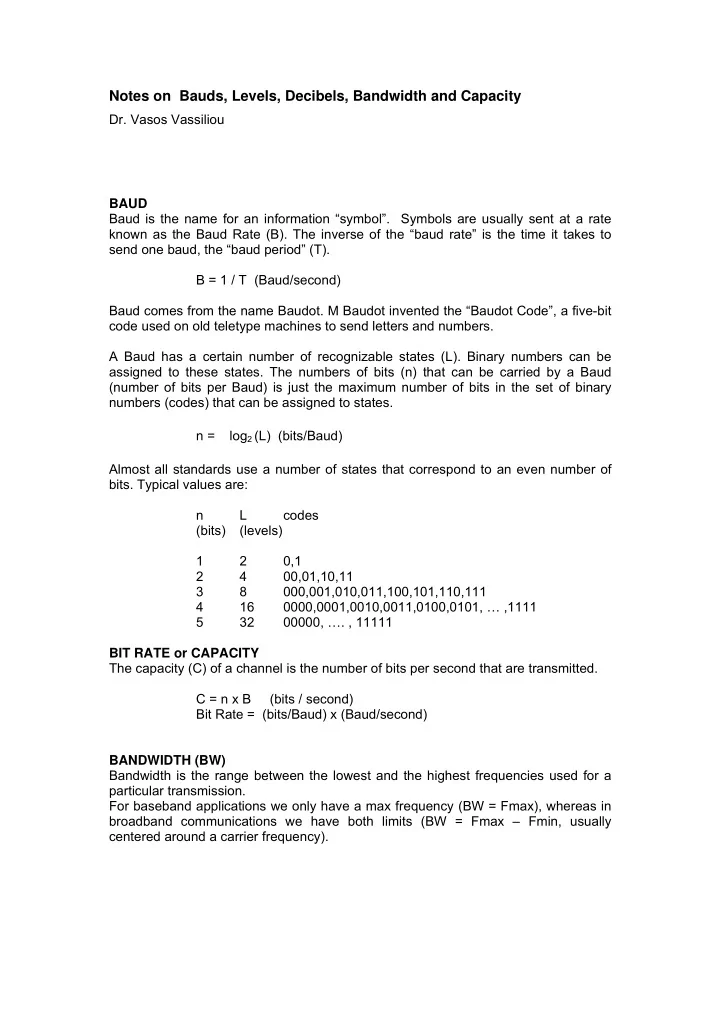

Notes on Bauds, Levels, Decibels, Bandwidth and Capacity Dr. Vasos Vassiliou BAUD Baud is the name for an information “symbol”. Symbols are usually sent at a rate known as the Baud Rate (B). The inverse of the “baud rate” is the time it takes to send one baud, the “baud period” (T). B = 1 / T (Baud/second) Baud comes from the name Baudot. M Baudot invented the “Baudot Code”, a five-bit code used on old teletype machines to send letters and numbers. A Baud has a certain number of recognizable states (L). Binary numbers can be assigned to these states. The numbers of bits (n) that can be carried by a Baud (number of bits per Baud) is just the maximum number of bits in the set of binary numbers (codes) that can be assigned to states. n = log 2 (L) (bits/Baud) Almost all standards use a number of states that correspond to an even number of bits. Typical values are: n L codes (bits) (levels) 1 2 0,1 2 4 00,01,10,11 3 8 000,001,010,011,100,101,110,111 4 16 0000,0001,0010,0011,0100,0101, … ,1111 5 32 00000, …. , 11111 BIT RATE or CAPACITY The capacity (C) of a channel is the number of bits per second that are transmitted. C = n x B (bits / second) Bit Rate = (bits/Baud) x (Baud/second) BANDWIDTH (BW) Bandwidth is the range between the lowest and the highest frequencies used for a particular transmission. For baseband applications we only have a max frequency (BW = Fmax), whereas in broadband communications we have both limits (BW = Fmax – Fmin, usually centered around a carrier frequency).
SIGNAL ENCODING The states in a simple “baseband” case would be voltage or current values (called “levels”). For “broadband” modulation the states could represent discrete values of amplitude and/or phase. The “states” must be far enough apart so that “noise” does not cause one state to be confused with another by the receiver (i.e. cause transmission errors). For example, 0 volts could be transmitted to represent the data bit “0” and 5 volts could represent the data bit “1”. If the average value of the voltage during a baud period is measured at the receiver, an average voltage of less than 2.5V could be interpreted as a “0” and a voltage above 2.5V as a “1”. Note that in the example above, the receiver must have a “clock oscillator” that is synchronized with the Baud rate and time of arrival, so that it knows when to start and stop averaging the voltage. The encoding scheme just described is called NRZ (non return to zero). More complicated encoding schemes, like RTZ or Manchester, may be used to enable better synchronization. DECIBELS dB = 10 log 10 (G) where G is a ratio of powers. Decibel Relationships: Ratio dB Quick Calculation 1 0 1.25 1 1.25=5/4=7dB-6dB 2 3 4 6 2*2 = 3dB + 3dB 5 7 10/2 = 10dB – 3dB 10 10 100 20 1000 30 0.1 -10 1/10 = 0dB – 10dB 0.5 -3 SAMPLING RATE According to Nyquist, to correctly sample a signal, the sampling aret needs to be at least twice the maximum frequency component of the signal. Sampling Rate ≥ 2 x Fmax CAPACITY NYQUIST rate If a channel has bandwidth BW, then the narrowest pulse (bit) that can be transmitted over that channel has width 1 τ = 2 BW Therefore the fastest rate at which pulses can be transmitted into the channel is given by the Nyquist rate Cmax = 2 BW bits/second
This rate is the theoretical maximum rate that is achievable through a baseband channel, with no intersymbol interference. For Broadband schemes, the maximum rate is given by: Cmax = BW / F Where F is the Baud Complication Factor in cycles / Baud) A table of F values for the most common schemes are: Scheme F Max changes per Baud (cycles per baud) NRZ 0.5 1 NRZI 0.5 1 RTZ 1 2 Manchester 1 2 Note that for Multilevel transmission, the bit rate is increased by a factor of n = log 2 (L) So the maximum theoretical capacity (bits/second) of the system according to the theorems of Nyquist is: Capacity (C) = 1/F x BW x log 2 (L) Bits/sec=1/(cycles/baud)xcycles/secondxbits/baud And using the minimum F=1/2 Capacity (C) = 2 x BW x log 2 (L) SHANNON’s THEOREM Real communication have some measure of noise. This theorem tells us the limits to a channel’s capacity (in bits per second) in the presence of noise. Shannon’s theorem uses the notion of signal-to-noise ratio (S/N) , which is usually expressed in decibels (dB). The noise level (N) is defined as the minimum spacing between voltage levels before random variations due to noise will cause the error rate t exceed some acceptable value (eg. 1 error in 10E12 bits). The maximum number of levels is given by = + L ( S / N 1 ) Which changes the Capacity equation to: Capacity (C) = BW x log 2 (S / N + 1)
Recommend
More recommend